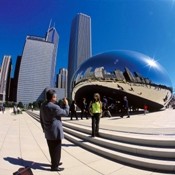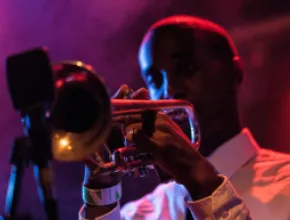Chicago is the Midwest’s largest metro and certainly its highest-profile city. With 2.8 million citizens anchoring a metropolitan area that totals nearly 10 million, it’s no wonder that Superman creators Jerry Siegel and Joe Shuster could easily fictionalize Chicago as the Man of Steel’s hometown by renaming it Metropolis.
That epic, larger-than-life feeling still tends to strike 21st century visitors: the skyscrapers that only a Kryptonian visitor could leap over; the trains that make Chicago the transportation capital of the Midwest, rumbling through subways and along elevated tracks; the way daring architecture seeps into the design of even parking garages and parks; the heroic size of the steaks and sausages; and the unearthly beauty of ocean-sized Lake Michigan as it sparkles in blue at the city’s eastern edge.
No wonder the Chicago Convention & Tourism Bureau’s current tagline is “Make No Little Plans. Choose Chicago.”
November’s election of former Illinois Sen. (and University of Chicago law professor) Barack Obama as president raised the Windy City’s profile even further, putting Chicago’s tony Hyde Park neighborhood front and center as the national media followed the Obamas’ every move.
The president-elect’s victory speech—live from Chicago—didn’t exactly hurt the city’s image, says Mark Theis, executive vice president of the Chicago Convention and Tourism Bureau.
“Admittedly that was a free $50 million ad campaign blasted around the world. It was fantastic to [know it was being seen] in Beijing or Rome and everybody was watching the victory speech in Grant Park.”
Of course, Chicago tends to get great headlines to begin with. It was both GQ’s and Fast Company’s 2008 city of the year and the Wall Street Journal’s top eating city, and four of its hotels graced Travel + Leisure’s Top 100 Hotels list, while Grant Achatz, chef of Alinea, captured the James Beard Foundation’s Outstanding Chef Award.
Chicago’s economy is widely diversified with contributions to its $440 billion gross metropolitan product coming from financial services, medical equipment, printing, publishing, food processing, insurance and, of course, tourism. It’s also the top U.S. city for air travel, served by O’Hare and Midway airports, which connect the city to 180 foreign and domestic destinations. Chicago is also a passenger-rail hub thanks to Amtrak service that links it with cities as distant as Los Angeles, New Orleans and Washington, D.C.
Visitor diversity may help Chicago do well in the face of recession-driven visitation downturns, according to Mark Theis.
“Luckily, Chicago is one of the few cities in the U.S. where the visitor base is one-third leisure, one-third business and one-third convention travelers,” he says. “We like to think of ourselves as one of the handful of cities that can sit on this three-legged stool, if you will.”
Theis says the Chicago CTB recently reallocated funds away from marketing buys toward helping organizers of consumer and business-to-business shows keep their numbers strong.
Few cities offer Chicago’s combination of large scale and a classically walkable urban environment. Sited on 29 miles of Lake Michigan lakefront, Chicago’s streets follow an orderly grid that’s only occasionally criss-crossed by diagonal streets or elevated freeways.
This makes it exceptionally easy to get around on foot, by car or in any of the numerous local and regional trains. Planners can turn attendees loose here during their free time and be pretty confident that they’ll find some of the city’s renowned museums, parks, stores and restaurants on their own.
Moviegoers may recognize Chicago’s downtown in the 2008 film Batman: The Dark Knight, where Art Deco-era bridges across the Chicago River and the warren of streets beneath Wacker Drive are clearly recognizable.
Chicago has about 30,000 hotel rooms within five miles of McCormick Place and a total of about 100,000 in the overall metropolitan area, aka Chicagoland. Downtown Chicago hotels can be divided into areas alongside or south of Grant Park, closest to McCormick Place and north of Grant Park in the Miracle Mile, River North and Gold Coast areas.
A number of new properties are opening in the city, which is diversifying the hotel product and giving the destination additional meeting space. One of the latest high-profile properties to open is Trump International Hotel and Tower Chicago, while another newcomer is The Blackstone, A Renaissance Hotel, a reincarnation of the historic Blackstone Hotel that originally opened in 1910. Upcoming additions include Shangri-La Hotel Chicago, Mandarin Oriental Tower Chicago and the Elysian Hotel.
The newcomers complement an extensive list of existing meetings-ready properties, including group favorites on the north end of town such as The Allerton Hotel; Ambassador East Hotel; Chicago Marriott Downtown; The Drake Hotel, which is undergoing a renovation; the newly renovated Doubletree Hotel Magnificent Mile; Four Seasons Hotel Chicago; the newly renovated Holiday Inn Chicago Mart Plaza; InterContinental Chicago; Millennium Knickerbocker; The Peninsula Chicago; Sheraton Chicago Hotel and Towers; Sofitel Chicago Water Tower; and Westin Michigan Avenue Chicago.
South of the Chicago River are meetings standouts such as Fairmont Chicago, Hard Rock Hotel Chicago, Hotel Allegro, Hyatt Regency Chicago, Palmer House Hilton, Renaissance Chicago and the newly renovated Swissotel Chicago, while closer to McCormick Place are Hilton Chicago and Hyatt Regency McCormick Place, which is undergoing a major expansion.
Beyond the hotels, groups can meet at venues such as the University Center downtown, with function rooms that range from 435 square feet to 1,440 square feet, as well as the Gleacher Center at the University of Chicago.
The city’s primary group venue is McCormick Place convention center, which recently unveiled the new 700,000-square-foot McCormick Place West building. McCormick Place attracts 3 million visitors annually and in 2009 will host events as varied as the Chicago Auto Show; the National Restaurant Association show; All Things Organic; the National Urban League’s annual conference; the American College of Surgeons’ 95th annual Clinical Conference; and even the Bank of America Chicago Marathon.
But McCormick Place is hardly the only facility in town with copious meeting space. To take just one example, Navy Pier, situated on Lake Michigan, offers 170,000 square feet for exhibits and over 48,000 square feet of dedicated meeting space, plus parking for 1,800 attendee vehicles.
There are also plenty of outdoor gathering options in town. The city’s parks include rentable spaces, such as the beautiful stage and graceful arches of Millennium Park’s Jay Pritzker Pavilion, while several charter boat services will take visitors out on Lake Michigan to sightsee (with an emphasis on architecture) and have dinner.
The city’s cultural attractions, several of which double as off-site venues, are all you’d expect from one of Lonely Planet’s top 10 cities in the world, and clustered relatively close together in the downtown area. Art lovers will flock to the Art Institute of Chicago, Museum of Contemporary Art and Smart Museum, football fans to Soldier Field, budding naturalists to the Field Museum, stargazers to the Adler Planetarium and Astronomy Museum, and animal lovers to Lincoln Park Zoo. Those interested in human progress can hit the Museum of Science and Industry, while aquatic life progresses through the Shedd Aquarium and music floats through the air at the Chicago Symphony Orchestra.
And for architecture fans, Chicago’s contribution runs the gamut from the first steel-framed skyscrapers ever built to Louis Sullivan’s design for what be came the Carson Pirie Scott department store; from Fazlur Khan’s designs for the Sears Tower and the John Hancock Centre, probably the two best-known jewels in the Chicago skyline, to the Wrigley Building and the neo-Gothic Tribune Tower, which face each other across North Michigan Avenue; all the way to one of Chicago’s newest additions, the Frank Gehry-designed Millennium Park, with its dramatic bandshell and arches looming gracefully over audiences for live music and other events, including group functions.
For food, consider another Chicago nickname, the “City of Big Shoulders.” One way Chicagoans’ shoulders may have become so big is by tackling the city’s thousands of restaurants head-on.
This is where the city’s ever-changing ethnic mix truly benefits the visitor. Of course, there are amazing steakhouses—it’s the Midwest, after all, and finding elegant places like Wildfire or Stetson’s at which to indulge beef and wine cravings isn’t exactly a problem.
And to be sure, there are a Greektown and Little Italy here as there would be in any sufficiently large American city. But there’s Asian food to be had in a Chinatown south of downtown and a Little Saigon north of Wrigley Field. Chicago is also famous for its deep-dish pizza, and two of city’s most famous pizza establishments are Giordano’s and Gino’s East.
At the higher end of the scale, Chicago’s growing Latin American population has clearly influenced Chef Rick Bayless, whose Frontera Grill and Topolobampo in River North continue to pack in crowds. Charlie Trotter’s is the center of its eponymous chef’s food empire and still a national foodie destination. And Jean Joho’s Everest—a name lacking any hint of the restaurant’s New French focus—continues to draw critical raves from its perch on the 40th floor of the Chicago Stock Exchange building.
It’s been many decades since Prohibition, and this shows at venues as varied as the two Goose Island Brewery brewpubs, classic hotel bars such as the Pump Room at the Ambassador East Hotel (immortalized in Judy Garland’s Chicago as well as Frank Sinatra’s frequent visits), and lush nightclubs such as Martini Park and Fulton Lounge.
For More Info
Chicago Convention and Tourism Bureau 312.567.8500 www.choosechicago.com






